Dell G2410H Review: A Green 24" LCD
by Brian Klug on May 7, 2010 1:43 AM EST
G2410H Color Quality
We’ll start out with the color quality of the G2410H. As per usual, we report two metrics: color gamut and color accuracy (Delta E). Color gamut refers to the range of colors the display is able to represent with respect to some color space. In this case, our reference is the AdobeRGB 1998 color space, which is larger than the sRGB color space. So our percentages are reported with respect to this number, and larger is better.
Color accuracy (Delta E) refers to the display’s ability to display the correct color requested by the GPU. The difference between the color represented by the display, and the color requested by the GPU is our Delta E, and lower is better here. In practice, a Delta E under 1.0 is perfect - the chromatic sensitivity of the human eye is not great enough to distinguish a difference. Moving up, a Delta E of 2.0 or less is generally considered fit for use in a professional imaging environment - it isn’t perfect, but it’s hard to gauge the difference. Finally, Delta E of 4.0 and above is considered visible with the human eye. Of course, the big consideration here is frame of reference; unless you have another monitor or some print samples (color checker card) to compare your display with, you probably won’t notice. That is, until you print or view media on another monitor. Then you’ll notice you were doing it wrong the whole time.
As I mentioned earlier, we’ve updated our display test bench, adding some things, tweaking others. One of the most significant changes we’ve made has been to depreciate the Monaco Optix XR Pro colorimeter in favor of an Xrite i1D2. Though the Monaco Optix colorimeter is a tried and true calibration workhorse with slightly better instrument consistency, the sad truth of the matter is that there are no longer up-to-date drivers for modern platforms.
We also plan to augment the Xrite i1D2 data with a Spyder 3 colorimeter. This way, we’re absolutely certain the data we’re gathering isn’t biased by instrumentation, and because we’ve heard good things about the Spyder 3. Unfortunately, we can’t wait any longer for it to get to our doorstep for this review, and Dell has been patient with us ;). We also have moved to the latest version of ColorEyes Display Pro - 1.52.0r32, though in practice this shouldn’t make a measurable difference.
The key takeaway is that we’re providing data from other display reviews taken with the Monaco Optix XR alongside new data taken with an Xrite i1D2. They’re still comparable, but we made a shift in consistency of operator (yours truly is doing display reviews now), and instrumentation, so the comparison isn’t perfect. It’s close, though.
So, how does the G2410 do? Well, let’s dive into the charts. As usual, we’ve disabled dynamic contrast on the display, set the brightness manually to 200 nits (which works out to almost exactly 50% on the OSD), and contrast at default.


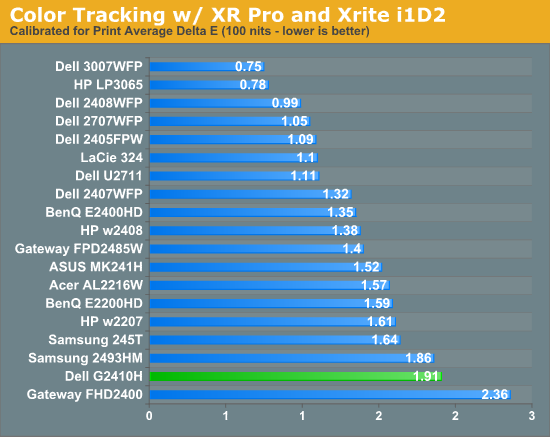
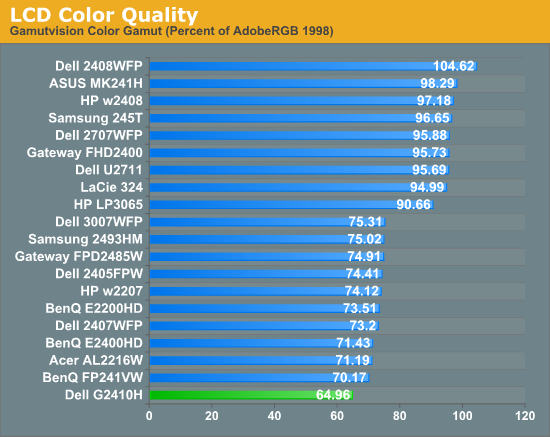
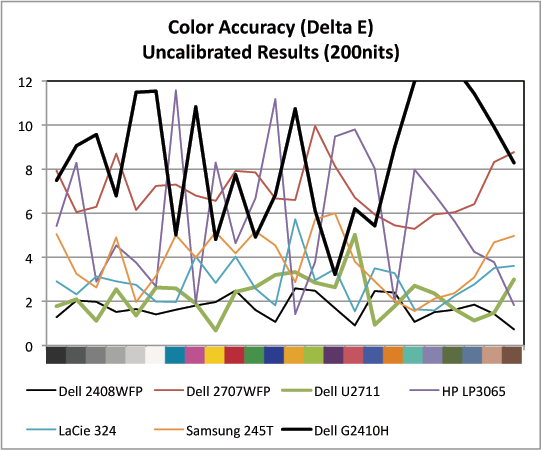
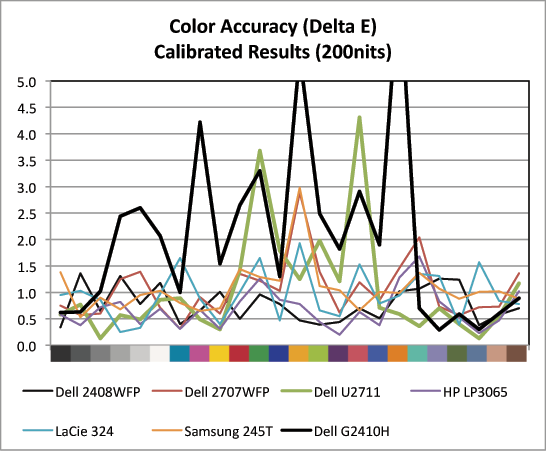
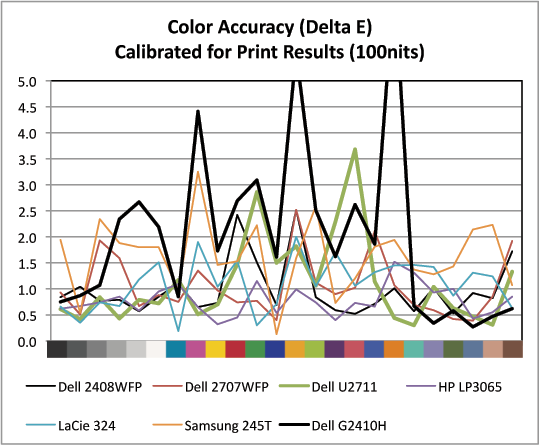
When we first setup the G2410H, the monitor was slightly cool in temperature. In fact, next to a few other calibrated displays, it was noticeably bluer. You can see that manifest itself in the uncalibrated results, which are rather high at 8.5 and show some peaks in the blues and greens (though the blues seem to be a difficult point for most monitors). Interestingly, the G2410H, try as I might, would not calibrate to a D65 (6500K) white point; repeated attempts on a variety of computers and versions of ColorEyes result in the LUT curves diverging and setting on a decidedly pinkish hue. Changing RGB values in the OSD and selecting from the few different options didn’t help, the outcome was still the same.
I’m chalking this up to the spectral performance of the WLED backlight. In practice, unless you’re dead-set on the white point matching adjacent monitors in a multiple-monitor setup, it’s not an earth-shattering deal, but unnerving still. After trying to make it closer to 6500, we eventually settled on using the panel’s native white point of around 7100K.
Calibrated performance is still totally acceptable for production at 2.01. Up against the considerably more expensive IPS panels we’ve tested, the G2410H doesn’t really stand out, but this is arguably very good performance from a TN display.
Finally, gamut is a bit disappointing at 64.95%. I was a bit shocked considering the LCD’s WLED backlight, until I found that Dell advertises 68% gamut coverage against a very similar color space to our AdobeRGB 1998 reference. We’re very close to that number, reference gamuts notwithstanding. It’d be nice to see much more coverage. Of course, a panel with RGB LED backlighting or CCFL could dramatically improve gamut. But possibly at the expense of burning more power and shattering the display’s “green” aura.
When it comes to color accuracy, the picture isn’t great, especially next to that IPS competition. There are some peaks above 4.0 and 5.0, which isn’t what we’d like to see in any monitor ever, but even the most discerning individuals would have a tough time picking those color differences out. Furthermore, keep in mind the target audience again; this seems like a productivity centric display.


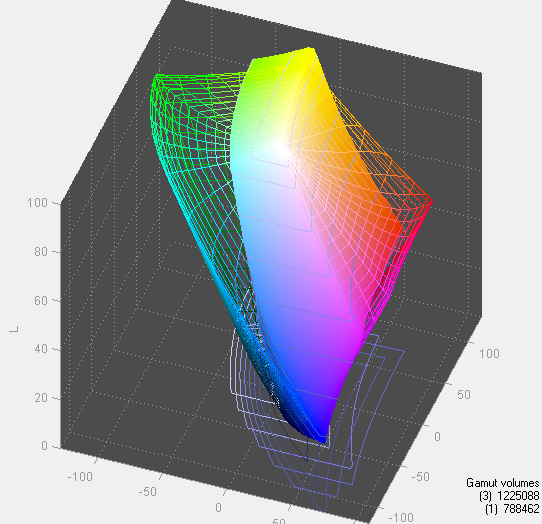








39 Comments
View All Comments
Calin - Friday, May 7, 2010 - link
Nice review, and if you mention it, I remember the nice sounds the CRT made when starting, stopping and changing graphic modes.I'm looking forward to more articles from you
QueBert - Friday, May 7, 2010 - link
That's what a REAL monitor does. My 22" Sony CRT will crush any LCD out there (literally) When I get on an LCD and turn it on to no sound I get pissed. When you turn a CRT on it lets you know it means business with the *BWHHH* it makes, and the click when you change resolutions is another thing missing from LCD.*HUGS his CRT* Nice and warm too :D
QueBert - Friday, May 7, 2010 - link
That's what a REAL monitor does. My 22" Sony CRT will crush any LCD out there (literally) When I get on an LCD and turn it on to no sound I get pissed. When you turn a CRT on it lets you know it means business with the *BWHHH* it makes, and the click when you change resolutions is another thing missing from LCD.*HUGS his CRT* Nice and warm too :D
pjconoso - Friday, May 7, 2010 - link
Now that is one manly comment right there!niva - Monday, May 10, 2010 - link
Right on, also real monitors (like a pair of 21" CRTs) give you sun tan. Only your closest friends will know that you never step outside of your house during the day.Brian Klug - Friday, May 7, 2010 - link
Thanks for the encouragement guys, I've got another monitor on my desk right now I'm working on as well, and the Spyder 3 just came in ;)There's a bunch more coming!
-Brian
Soulkeeper - Friday, May 7, 2010 - link
Still looking for an LCD that won't be a downgrade from 10yr old CRT technology.1920x1080 for a 24" display doesn't get me excited.
dieselJosh - Friday, May 7, 2010 - link
For the price $339, one can acquire one or more flagship CRT units, such as the fw900 or a7217a.Any event horizon guesses for when flat panel displays will be able to compete with such CRTs performance for gaming?
Zingam - Friday, May 7, 2010 - link
I have an older 22 inch version that looks the same. I love it. The only one thing that bothers me is the frame! Can't they make the screen and the frame flat. The frame with that shape collects so much dust it's unbelievable. That's not the problem - the problem is the cleaning then!blueeyesm - Friday, May 7, 2010 - link
The problem isn't it collects dust easily; it's that there's too much dust in that room.Run the vacuum more often.